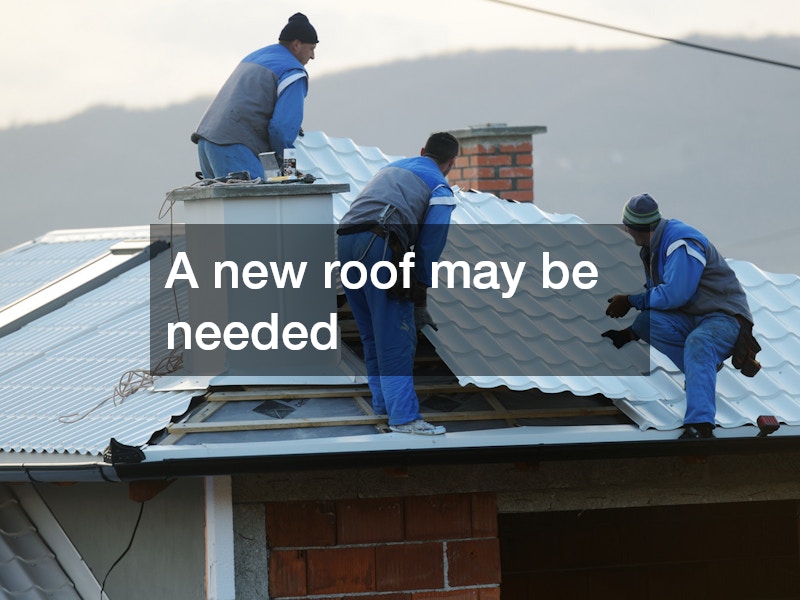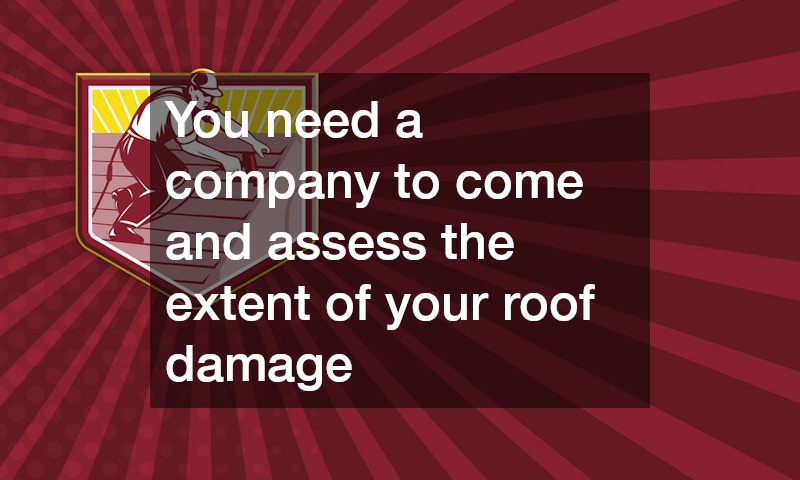
When investing in emergency roof repair services, there are many things to consider. First, you need a company to come and assess the extent of your roof damage. They should consider the age of your current roof and check to see if it is missing shingles, if the shingles are cracked, or if the roof is sagging. When considering emergency roof repairs, you must also consider the cost of labor and repairs, price of materials, warranty, energy efficiency of the roofing materials, and the availability of a roofing contractor to fix your damaged roofing.
A roofing professional will help you determine if a simple same-day roof repair is needed or if more extensive work should be done. Homeowners should prioritize a roof maintenance schedule as part of their roofing emergency preparedness plan as a preventative measure that could save thousands of dollars when a roofing emergency occurs.
Roof repairs will likely be recommended if you have buckling or curling shingles, water leaks in the interior walls or the attic, missing shingles, or shingles that are visibly cracked. Furthermore, when calling a contractor for emergency roof repairs, a new roof may be needed if you have a sagging roof line, damage to vents or flashing around your chimney, and an overgrowth of mold and algae.

Did you know? The need for roofing services has been predicted to increase by almost 5% annually until 2021. If you’ve been considering roof replacement or other roofing services, you may be wondering what to know about roofing before having yours fixed.
If so, then you’ve come to the right place. In this article, we’ll discuss what to know about roofing before you call the local residential roofing services. To have all your most important questions answered, keep reading.
Signs That Your Roof Needs Replacing
Replacing a roof is expensive and time-consuming, but it needs to be done at least once every couple of decades. If it hasn’t been that long since the roof on your house was built and there isn’t any major damage, you might be able to get away with minor repairs. However, if you notice any of the following signs, it’s a sure signal that your roof needs to be replaced completely. Read on to learn what to know about roofing.
Your Roof is Old
The maximum lifespan of a residential roof is considered by experts to be between 20 and 25 years. If your roof is approaching 20 years old or older, it’s important to get local contractors roofing on it within the year.
Your Shingles are Buckling or Curling
Go up on top of your roof and inspect the condition of the shingles. Pay special attention to the slopes of your roof that commonly receive direct sunlight. Are the shingles curling or losing granules? If so, they may need to be replaced. Consult a contractor for additional advice.
The Roof Valleys are Showing Wear
The valleys of your roof — the sections in corners and between stretches of roof — are some of the most critical parts of the entire structure. This is because rainwater needs to flow through them to get to the gutters, which makes them especially vulnerable to leaks. If any of these areas of your roof are showing damage, such as broken or missing shingles, it’s time for a new roof.

You’re Using Tar or Cement Chimney Flashing
Modern buildings should be constructed with metal flashing around chimneys and other protrusions on the roof. These are water-tight and more long-lasting, preventing damage from leaks and wear. If pipes or chimneys on your roof have flashing made with tar or cement, you should have these replaced with a metal flashing system.
Your Roof is Sagging
This is one of those things construction law attorneys don’t like to see. A sagging roof indicates a serious problem that’s usually a structural issue that affects your whole house. The issue might be with the attic decking, but it could also be your home’s foundation supports. While you might not be in immediate danger, the problem is much easier to resolve when it targets a small area. If it’s spread all over the roof, it’s not good.
Shingle Granules are Found in Your Gutters
If you’re walking around on your roof and look down inside your gutters to see a lot of broken-off shingle granules, this could be a problem. Shingles start to lose their granules as a roof reaches the end of its lifespan. Another sign of granules coming off is when shingles show darker or inconsistent color on certain areas of the roof.
Daylight is Able to Shine in Between Roof Boards
As part of your roof inspection, go into your attic and take a look around. Look up at the bottom of your roof. If you see light filtering in between cracks in your roof, you have a serious problem. Call your commercial roofing services right away to replace your roof.

When it comes to what to know about roofing, the above signs may be most important. Next, we’ll talk about the top things it’s important to know before you have a new roof installed.
What to Know About Roofing Before Having a New One Installed
If you realize your roof desperately needs to be replaced, that doesn’t mean you should run out to the nearest hardware store and pick up supplies. There are several factors you should consider first. The following is what to know about roofing before having yours replaced.
Choose the Right Material
One of the most important decisions you will make for your new roof is the materials you will use for it. When considering a material, think about its appearance, price, and lifespan. You should do that for each product you need for the roofing project. For example, asphalt roofing shingles are highly economical, but you’ll pay for that in the long term because they aren’t very durable. If you’re interested in making a long-term investment, concrete or metal shingles are typically the better choice.
Aside from traditional shingle options, such as asphalt, shakes, and slate, there are less conventional options you might consider. There are beautiful metal roofs that mimic the appearance of more traditional options. Meanwhile, architectural shingles a dramatically superior to traditional asphalt shingles, in terms of both looks and performance. Although options like these might be pricier than cheap shingles, they will make up for it in both lifespan and curb appeal.
If your roof hasn’t been replaced in 20 years, don’t simply settle for the same material you have now. Take a look at new materials and colors that might work well for your house. You may even decide to give your walls a new coat of paint to go along with your new roof once it’s installed.
Any time you’re weighing different options, keep in mind the pros and cons of each possibility. If you can’t make up your mind, hire an expert to make recommendations based on the design of your house.
Choose Either Peeling Off our Layering On
Another important decision you will make is whether you will remove the existing shingles before having new ones installed. You might be surprised to learn that that’s an option — yes, it is possible to install a new roof over the top of an old one. That doesn’t mean it’s the ideal option, however.
Most building codes will not allow your roof to have more than two layers of shingles on it, so if you or a previous owner has layered on shingles once before, that won’t be an option this time. A roof replacement contractor will be able to inspect your roof and tell you if there are already two layers of shingles up there.
Even if you’re technically allowed to install an additional layer of shingles on your roof, keep in mind that this will add a bit of extra stress to your roof. For that reason, it’s usually best to peel off the old layer of shingles before putting on a new one, no matter what. However, if you simply don’t have enough time for the entire project or are trying to save money, you may opt to simply install a new roof on top.
Finally, to install a second layer of shingles on your roof, the existing roof must be in decent condition. If the existing shingles are curling up or the roof is uneven, it will be best to peel them up. You might also choose to peel the old roof up first to install an ice and water shield underneath the new roof. This is especially helpful in cold climates.
Examine Your Roof Frame
Before you do anything else, it’s a good idea to inspect the plywood that supports your roof. This applies even if you haven’t had problems with leaking in the past. If you discover areas of the plywood where the material is soft or broken, you should replace it right away. This is especially the case if you find that the plywood is disintegrating in places. It’s also advisable to remove the existing layer of roofing and examine it, before beginning installation. If you notice and fix leaks in the roof frame itself, the life of your roof can be prolonged. It can also help you avoid more severe leaks down the road.

Consider Installing it Yourself
If you’re like the vast majority of homeowners, taking on the massive task of installing your roof may not be a great idea. But if you’re one of the few people who not only have the tools, but the knowledge and experience necessary for the job, you might consider doing it yourself. Keep in mind that any attempts at construction around your house should be limited to minor repairs. For example, replacing a couple of asphalt shingles might be manageable for you. However, you should keep in mind that your homeowner’s association might have rules against making repairs if you’re not a licensed contractor. Take into consideration any local building codes and other regulations before attempting anything yourself. To play it safe, this kind of thing is best left to a professional.
Select the Right Contracting Company
When you need to find out what to know about roofing, this step is critical. As with many things in life, the most important thing isn’t to know how to fix your roof, but how to choose a qualified expert for the job. To avoid needless complications or unfortunate run-ins with work injury lawyers, follow our tips for choosing the right contracting company:
- Make calls to various roofing companies and interview all of them, either on the phone or in person.
- Request quotes or price for your project from the contractors you like best.
- Make sure the roofing contractor you speak with can work with the type of material you’ve chosen. All roofers can work with asphalt shingles, but some may not have experience with rubber, concrete, or other unconventional materials.
- Get references from friends and tradespeople whom you trust. Commercial roofing isn’t based on repeat business, so customer satisfaction tends to be less of a priority in that industry. Check for online reviews while you’re at it.
While there’s no way to guarantee a particular result, by doing your due diligence, you can help ensure you get the services you need without too much difficulty.
Keep in Mind That Roofing is Noisy
One great thing about outsourcing construction work is that it poses no danger to you. You should still consider hiring an estate planning attorney if you’re getting older, but it’s nice to know you don’t need to worry about losing your life to a building project. Part of what to know about roofing, however, is that it’s very loud.
When you’re making plans to have your roof replaced or repaired, remember that it’s a noisy process.
From stripping off old shingles to hammering down new ones, there’s going to be a lot of racket, and your neighbors, family, or HOA might not be fully on board.
To make things as stress-free as possible, alert your neighbors (and homeowner’s association, if necessary) about your plans to rebuild your roof. Let them know when the contractors will arrive and how long they’re likely to be working. If you have family members or pets who are sensitive to loud noises, you might want to move everyone out of the house for a few days while the work is being done. You might spend some time at a local park, or maybe even relaxing at a medical spa.
As a side note, if you need to drive somewhere while the work is being done, you might want to move your car out of your driveway before the work begins. Roofing a house takes a huge amount of shingles, and some contractors pull a big truck full of them into the driveway and leave it there while they work. If you don’t get your car out early in the morning before the contractors arrive, you could end up blocked in.
Ask the Roofer for a Contract
As we mentioned earlier, more of what to know about roofing involves dealing with contractors than anything else. Before any work begins, make sure you request a contract from your roofing contractor. It should clearly indicate everything you’ve agreed upon: the work to be done, in detail, as well as payment terms and amount. The shingle type, color, roof area to be targeted, and other details regarding the exact nature of the work should all be included. Other things to note include layering, stripping, and flashing, as well as any other details that apply specifically to your project. If you’ve agreed to help cover the cost of equipment maintenance, such as Ramset tool repairs, make sure this is written down too. Getting everything in writing can help prevent problems and misunderstandings later.

Keep Your Roof in Good Repair from Now On
Of course, getting your roof repaired or replaced is only half the battle. The last part of what to know about roofing involves what to do after the contractors have left.
As you can see, getting a roof replaced is a complicated task, and one you should avoid having to do more than once every few decades. To make sure that happens, remember to inspect and clean your roof regularly. Keep up with seasonal maintenance work. And don’t forget to call your roofing contractor again for small repairs later on.
And with that, you should now understand all of what to know about roofing as a homeowner. Good luck with your new roofing adventures!


